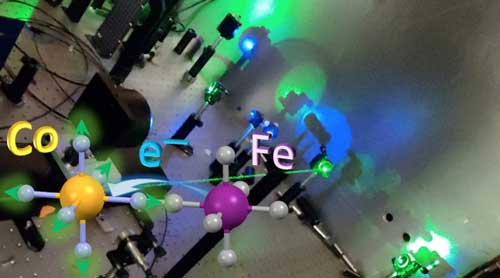| Dec 08, 2020 |
Observing the ultrafast motion of atoms and electrons
(Nanowerk News) Photo-induced electron transfer is central to numerous physical processes, for instance in the magnetization of materials.
|
|
The quest to understand and control this ultrafast process has long been pursued in vain, with no answer to the question of whether electrons induce atomic motion, or vice versa.
|
|
To answer this question, the atomic equivalent of the paradox of the chicken and the egg, a consortium of scientists led by the Institute of Physics in Rennes (CNRS/Université de Rennes 1)1 used an X-ray laser (X-FEL) located in Stanford.2
|
|
This latest-generation instrument can observe, in real time, the electrons and atoms that make up matter. In the system studied, experiments showed that light triggers the ultrafast distortion of the molecular structure of cobalt atoms.
|
|
This leads to the transfer of iron atoms toward cobalt atoms, thereby making the system magnetic.
|
 |
| hotomagnetism can be achieved through atomic motion that leads to the transfer of electrons. (Image: Eric Collet, Institute of Physics in Rennes, CNRS/Université de Rennes 1)
|
|
This research, published in Nature Chemistry ("Charge-transfer driven by ultrafast spin-transition in a CoFe Prussian blue analogue"), shows that it is possible to distinguish between the electronic dynamics of atomic motion on the scale of one tenth of one millionth millionth of a second (or 100 femtoseconds).
|
|
This opens the way for the development of a science that can control materials through light.
|
Notes
|
|
1 This research also involved scientists from the Institute for Molecular Chemistry and Materials in Orsay (CNRS/Université Paris-Saclay), the Institute of Condensed Matter Chemistry in Bordeaux (CNRS/Université de Bordeaux/Bordeaux INP), the ESRF, the University of Rome (Italy), the Linac Coherent Light Source at the SLAC National Accelerator Laboratory (Stanford, United States), and the Lebanese German University (Jounieh, Lebanon).
|
|
2 The LCLS X-ray Free-electron Laser (X-FEL) is a machine measuring multiple kilometres providing flashes of X-ray light, which can follow, in real time, the dynamics of electrons and atoms after their excitation by light.
|

